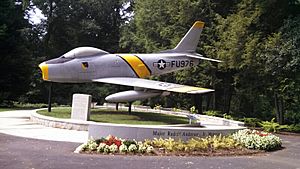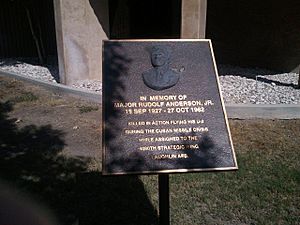Rudolf Anderson facts for kids
Quick facts for kids
Rudolf Anderson
|
|
|---|---|

Major Rudolf Anderson, USAF
|
|
| Nickname(s) | Rudy/Andy |
| Born | September 15, 1927 Spartanburg, South Carolina, U.S. |
| Died | October 27, 1962 (aged 35) Near Banes, Cuba |
| Buried |
Woodlawn Memorial Park
Greenville, South Carolina, U.S. |
| Allegiance | |
| Service/ |
|
| Years of service | 1951–1962 |
| Rank | |
| Unit | 4028th Strategic Reconnaissance Squadron, 4080th Strategic Reconnaissance Wing, Strategic Air Command |
| Battles/wars | Korean War Cuban Missile Crisis † |
| Awards | Air Force Cross Distinguished Flying Cross (3) Purple Heart Cheney Award |
| Alma mater | Clemson University, B.S. 1948 |
| Spouse(s) | Frances Jane (Corbett) Anderson (1935–1981) |
| Children | 2 sons, 1 daughter |
Rudolf Anderson Jr. (born September 15, 1927 – died October 27, 1962) was an American pilot in the United States Air Force. He was the first person to receive the Air Force Cross. This is the second-highest award for bravery in the U.S. military. Major Anderson was the only American killed by enemy action during the Cuban Missile Crisis. His U-2 spy plane was shot down over Cuba. Before this, he served in Korea after the Korean War ended.
Contents
Early Life and Education
Rudolf Anderson Jr. was born in Spartanburg, South Carolina. This city is close to Greenville. As a young person, he became an Eagle Scout. This is the highest rank in the Boy Scouts. He was part of Troop 19 in Greenville.
He went to Augusta Circle Elementary School. Then he graduated from Greenville High School in 1944. In 1948, he earned a college degree. He studied Textile Engineering at Clemson University in Clemson, South Carolina. He was also part of the Air Force ROTC program. For three years after college, he worked in Greenville.
Joining the Air Force
Anderson joined the Air Force in November 1951. This was during the Korean War. In 1952, he became a Second Lieutenant. He finished his pilot training and earned his pilot wings in February 1953.
He started his flying career with RF-86 Sabres. These were reconnaissance planes. He earned two Distinguished Flying Crosses. These awards were for his spy missions after the Korean War. He was based at Kunsan Air Base in South Korea. He also flew missions from Komaki Air Base in Japan. In April 1955, he came back to the United States.
Later, he became a U-2 pilot. He qualified on the U-2 plane on September 3, 1957. He became the best U-2 pilot in his unit. He had flown over a thousand hours in the U-2. This made him very important for U.S. spy missions over Cuba in 1962.
The Cuban Missile Crisis
The Lockheed U-2 spy planes flew very high. At first, the Central Intelligence Agency (CIA) used them for missions over Cuba. But on October 14, 1962, the Air Force took over these missions. They used the same CIA U-2 planes, but painted them with Air Force symbols.
Major Anderson was part of the 4028th Strategic Reconnaissance Weather Squadron. This unit was based at Laughlin Air Force Base in Texas. On October 15, CIA experts looked at photos from the first Air Force flight. They found SS-4 medium-range ballistic missiles in Cuba. These pictures started the Cuban Missile Crisis. This was a very tense time between the U.S. and the Soviet Union.
On Saturday, October 27, Major Anderson began his sixth mission over Cuba. He flew a U-2F Dragon Lady plane. He took off from McCoy Air Force Base in Orlando, Florida. A few hours into his flight, his plane was shot down. This happened over Banes, Cuba. Two Soviet-supplied S-75 Dvina (also called SA-2 Guideline) surface-to-air missiles were fired at his plane. Soviet generals in Havana gave the orders to fire.
A CIA document from October 28, 1962, said Major Anderson likely died when the missile exploded. Pieces from the exploding warhead probably hit his pressure suit. This caused his suit to lose air at a high altitude.
On October 31, the Acting Secretary-General U Thant announced Anderson's death. He had just visited with Premier Fidel Castro in Cuba. Cuba returned Anderson's body on November 4. He was buried at Woodlawn Memorial Park in Greenville two days later.
President John F. Kennedy ordered that Anderson receive several awards. He was given the first Air Force Cross. He also received the Air Force Distinguished Service Medal, the Purple Heart, and the Cheney Award. On July 26, 2011, Anderson was honored again. He was added to the Air Force Reserve Officer Training Corps Distinguished Alumni.
Major Anderson was the only combat death among the eleven U-2 pilots who flew over Cuba during the crisis. The other ten pilots each received the Distinguished Flying Cross. Other airmen also died during this time. Eleven crew members died in three RB-47 Stratojet crashes. Seven more airmen died when a Boeing C-135 Stratolifter crashed near Guantanamo Bay Naval Base on October 23.
Wreckage of the U-2
Some parts of Major Anderson's plane are on display in Cuba. You can see them in three different museums. One of the engine air intakes is at the Museo de la Lucha contra Bandidos in Trinidad. The engine and part of the tail are at the Museum of the Revolution in Havana. The right wing, another part of the tail, and the front landing gear are at the Fortaleza de San Carlos de la Cabaña in Havana.
-
The engine of the U-2F in the Museum of the Revolution in Havana.
Military Awards and Honors
Major Anderson received many military awards for his bravery and service.
| Senior Pilot Badge | ||
| Air Force Cross | ||
| Air Force Distinguished Service Medal | Distinguished Flying Cross with 2 oak leaf clusters | Purple Heart |
| Air Medal with 1 oak leaf cluster | Presidential Unit Citation | National Defense Service Medal with 1 bronze star |
| Korean Service Medal with 1 bronze star | Armed Forces Expeditionary Medal | Air Force Longevity Service Award with 1 oak leaf cluster |
| Republic of Korea Presidential Unit Citation | United Nations Service Medal | Republic of Korea War Service Medal |
Other Recognitions and Memorials
Many places and awards honor Major Rudolf Anderson Jr.:
- He received the Cheney Award in 1962.
- Anderson Elementary School at Eielson Air Force Base in Fairbanks, Alaska was named after him in 1964.
- A group at Clemson University, the Maj. Rudolf Anderson Jr. Squadron of the Arnold Air Society, is named in his honor.
- American Legion Post 214 in Greenville, South Carolina, was named after him in 2015.
- A memorial was built for him in 1963 at Cleveland Park in Greenville. It was updated and rededicated on October 27, 2012. This was the 50th anniversary of his death.
- A building at Laughlin AFB, Texas, was renamed "Anderson Hall" in 2001. This building is for the 47th Operations Group.
- Anderson was added to the South Carolina Aviation Hall of Fame in 2008.
- In 2019, he was inducted into the Greenville County Schools Hall of Fame.
In Popular Culture
The story of Major Anderson's U-2 spy plane being shot down over Cuba is shown in the 2000 film Thirteen Days. Actor Charles Esten plays the role of Anderson in the movie.








